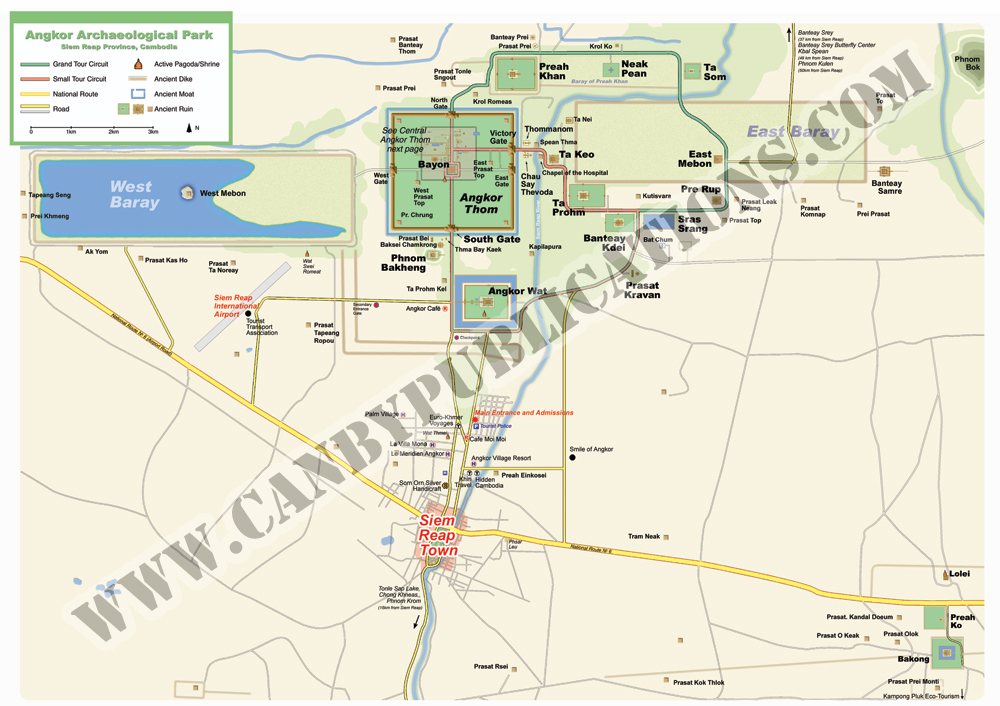The skies are becoming an ominously dark as more and more clouds gather together. Although they were vividly blue this morning, they are now dramatically darker, almost resembling mercury. The scene feels straight out of a classic Hitchcock film, the calm before an attack by four dozen violent birds or a lunatic transvestite with an Oedipus Complex. What's worse, 216 stone faces are staring down at me, eyes closed as if they are secretly plotting. Though the faces wear stoic expressions, the edges of their mouths are slightly upturned, making the stone creatures look slightly nefarious, as if they are hiding some recently committed mischief. The stone beings have oversized, pear-shaped noses, which immediately pick up on my presence upon entering their hallowed grounds. No matter where I turn the faces stare down at me, constantly judging.
For the second part of the afternoon, Amit, Louise, and I are visiting Angkor Thom, the first stop of which is the spectacular Banyon Temple. The complex was built in the late 12th Century by King Jayavarman VII as a Mahayana Buddhist shrine. The sandstone temple is centered around thirty-seven remaining towers (originally forty-nine), each with four faces carved directly into the north, south, east, and west sides. Some scholars believe the faces are of Jayavarman himself, constantly watching his servants. Others believe them to be the faces of Lokesvara, an enlightened Buddhist being, although neither theory has been proven. The stone beings are relatively identical from one tower to the next, most with closed eyes, crooked smiles, large flat noses, and bejeweled headdresses. The presence of the faces lends an energy to Banyon that even Angkor Wat's classical Khmer architecture lacks -- the grounds feel curiously alive. Especially as the weather dramatically changes from blue skies to shimmering silver cloud cover to raging thunderstorms within minutes of our entrance. Like Angkor Wat, Banyon is decorated with several friezes and bas-reliefs, encompassing nearly one mile in length, and incorporating over 11,000 figures.
 |
| Lean on me, when you're not strong, and I'll be your friend, I'll help you carry on |
Banyon is located in the center of Angkor Thom, a six square mile complex that literally means "Great City." King Jaryavarman VII built the city as the capital of his Khmer Empire in the late 12th Century. In its heyday, Angkor Thom had a population of over one million, at a time when London only was home to 50,000. Angkor Thom lies east of the Siem Reap River and like Angkor Wat is surrounded by a boat. There are four entrances into the ancient city, guarded with 60 ft. Banyon-style towers adorned with quad-faces. If the stone faces do not intimate enemies, the feral monkeys guarding the entrances certainly will. As with Angkor Wat and several other temples around Siem Reap, Thom's entrances are anointed with large causeways symbolizing good versus evil. On one side are 54 enlightened Buddhist gods, Devas, with the opposing side occupied by 54 evil Asuras. Both groups of deities hold giant nagas, the mythological serpent god, as if they are trying to harness his power.

 |
| Benevolent Buddhist gods, Devas, protecting the entrance of Angkor Thom |
Baphuon is one of Angkor Thom's premiere temples which, like Angkor Wat, was designed to be a representation of the mythical Mt. Meru. The temple was constructed in the 11th Century by King Udayadityavarman II. During the mid-twentieth century, archaeologists completely took apart Baphuon to better understand the ancient Khmer Empire, only to have their research and progress destroyed by the Khmer Rouge. The temple was only recently restored, open to the public in 2008. A restored stone bridge, supported by hundreds of columns, leads to Baphuon's entrance. The Western face of the temple is fashioned into a large reclining Buddha, almost 200 ft. in length.
 |
| Path to Baphuon |
 |
| Baphuon |
Phimeanakas was the former royal palace of Angkor Thom, built at the end of the 10th Century by King Rajendravarman. Legend has it that the king spent every evening in the palace's northern tower with a woman he believed to be the human reincarnation of the naga, the mythical Buddhist serpent god. Not even the queen could disturbe this affair. It is said the relationship was mutually beneficial and had to be sustained for the prosperity of the kingdom -- if the the king didn't show for the nightly dalliances, the empire's land would be in danger (as the naga was a protector of the sea and the land); if the reincarnated naga didn't show, the king's death was imminent. As this extramarital affair seemed necessary to preserve the empire and health of all of its civilians, I guess the king came up with a good excuse. Philandering politicians should try using the naga excuse today when they are caught in Minneapolis airports. That said, given that the naga god embodies the form of a large snake, the king's affair danced a fine line with bestiality. The entrance to Phimenakas is known as the Terrace of the Elephants, a 350 meter long patio decorated with short-trunked elephants and female dancers, both of wear elaborate headdresses. The terrace was used as audience seating for grand public festivals and speeches. Khmer Empire citizens would sit beside the statues, watching the king's cavalcade pass, made up of horse-drawn chariots, warriors, elephants, and servants.
 |
| Phimeanakas |
























No comments:
Post a Comment